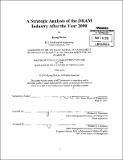| dc.contributor.advisor | Michael A. Cusumano. | en_US |
| dc.contributor.author | Lee, Kyung Ho, S.M. Massachusetts Institute of Technology | en_US |
| dc.contributor.other | Sloan School of Management. | en_US |
| dc.date.accessioned | 2013-09-24T19:42:00Z | |
| dc.date.available | 2013-09-24T19:42:00Z | |
| dc.date.copyright | 2013 | en_US |
| dc.date.issued | 2013 | en_US |
| dc.identifier.uri | http://hdl.handle.net/1721.1/81087 | |
| dc.description | Thesis (S.M. in Management Studies)--Massachusetts Institute of Technology, Sloan School of Management, 2013. | en_US |
| dc.description | Cataloged from PDF version of thesis. | en_US |
| dc.description | Includes bibliographical references (p. 42-43). | en_US |
| dc.description.abstract | The DRAM industry has been growing in line with the development of information technology since the 1970's. However, the industry has become commoditized and is well known for its recurring cycle of upturns and downturns, resulting in a number of bankruptcies, mergers and acquisitions. Specifically, the years following 2000 became increasing challenging for the key DRAM producers that remained in the market. The combination of demand shifts to consumer oriented electronics and rising manufacturing costs reduced profitability across the industry. As these conditions persist, DRAM producers need to find a way to generate sustainable profit and to create buffers against imminent downturns. This thesis details the industry level problems DRAM vendors have faced in the past, the dynamics that have caused recurring industry cycles and commoditization, and how those dynamics affect the industry. In this context, the thesis concludes with two suggestions for potential strategies for market differentiation. First, DRAM producers should strengthen services that provide opportunities to differentiate their value proposition to customers while simultaneously generating new sources of profit. Second, DRAM market leaders should continue to focus heavily on R&D of high performance products while carefully managing the timing of new product launches to maximize profits. | en_US |
| dc.description.statementofresponsibility | by Kyung Ho Lee. | en_US |
| dc.format.extent | 43 p. | en_US |
| dc.language.iso | eng | en_US |
| dc.publisher | Massachusetts Institute of Technology | en_US |
| dc.rights | M.I.T. theses are protected by
copyright. They may be viewed from this source for any purpose, but
reproduction or distribution in any format is prohibited without written
permission. See provided URL for inquiries about permission. | en_US |
| dc.rights.uri | http://dspace.mit.edu/handle/1721.1/7582 | en_US |
| dc.subject | Sloan School of Management. | en_US |
| dc.title | A strategic analysis of the DRAM industry after the year 2000 | en_US |
| dc.title.alternative | Strategic analysis of the Dynamic Random Access Memory industry after the year 2000 | en_US |
| dc.type | Thesis | en_US |
| dc.description.degree | S.M.in Management Studies | en_US |
| dc.contributor.department | Sloan School of Management | |
| dc.identifier.oclc | 858010748 | en_US |
